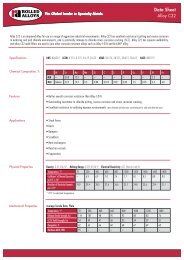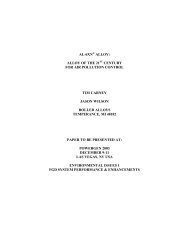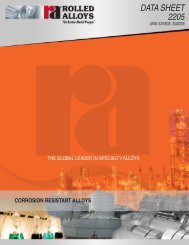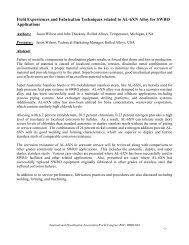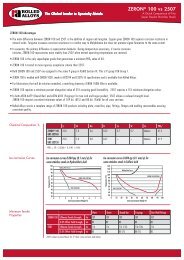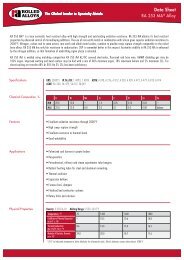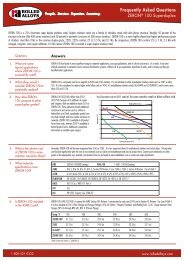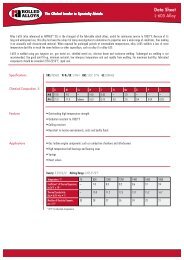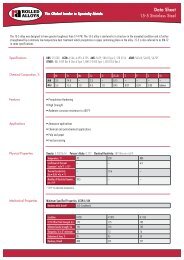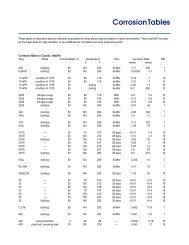Alloy Performance Guide - Rolled Alloys
Alloy Performance Guide - Rolled Alloys
Alloy Performance Guide - Rolled Alloys
Create successful ePaper yourself
Turn your PDF publications into a flip-book with our unique Google optimized e-Paper software.
<strong>Alloy</strong> <strong>Performance</strong> <strong>Guide</strong>People. Service. Expertise. Inventory.
People. Service. Expertise. Inventory.Table of Contents<strong>Rolled</strong> <strong>Alloy</strong>s, Who We Are 2Application Engineers 2Heat Resistant <strong>Alloy</strong>s 3Corrosion Resistant <strong>Alloy</strong>s 4Mechanical and Physical Properties in the Annealed Condition 5Maximum Allowable Design Stresses [ASME Boiler and Pressure Vessel Code 2007] 5Maximum Allowable Design Stresses [ASME Boiler and Pressure Vessel Code 2007] 6Minimum Creep Rates at Temperature [446, 309, 310, RA330, RA 253 MA and RA333] 7Stress to Rupture at Temperature [446, RA330, RA333, RA 253 MA, 601, RA 602 CA] 8High Temperature <strong>Performance</strong> <strong>Guide</strong> 9Wet Corrosion <strong>Performance</strong> <strong>Guide</strong> 9General Corrosion 10Corrosion Rates 10Sulfuric Acid - Iso-corrosion curves [304L, 316L, LDX 2101, 2205, AL-6XN and ZERON 100] 11Sulfuric Acid - Iso-corrosion charts [Stainless Steels] 11Sulfuric Acid - Iso-corrosion charts [<strong>Alloy</strong> 20] 12Iso-corrosion for Hydrochloric Acid 12Iso-corrosion for Phosphoric Acid 12Pitting and Crevice Corrosion 13Pitting and Crevice Corrosion Resistance Chart 13Stress Corrosion Cracking 13Stress Corrosion Cracking Resistance [U-bend samples in boiling chloride solutions] 14Threshold Temperatures for Chloride SCC in 3% Sodium Chloride 14Maximum Suggested Temperatures for Heat Resistant <strong>Alloy</strong>s 14High Temperature Oxidation Resistance 15Welding Data [Like Metals] 16Suggested Weld Fillers [Dissimilar Heat Resistant Metals] 16Suggested Weld Fillers [Dissimilar Corrosion Resistant Metals] 17Machining 17-181<strong>Rolled</strong> <strong>Alloy</strong>s
<strong>Alloy</strong> <strong>Performance</strong> <strong>Guide</strong><strong>Rolled</strong> <strong>Alloy</strong>s<strong>Rolled</strong> <strong>Alloy</strong>sStrength of a company lies in the strength of its people. At <strong>Rolled</strong> <strong>Alloy</strong>s, our people are the core of ourcompany. We offer nearly sixty years of experience and expertise working with specialty alloys.From the smallest cut piece to the largest bulk order, <strong>Rolled</strong> <strong>Alloy</strong>s offers a full bill of materials in plate,sheet, bar, pipe, forgings, fittings, flanges and welding consumables. Our global cutting services include:waterjets, lasers, plasmas, saws, shears, coil levelers, straighteners and billet conversion.<strong>Rolled</strong> <strong>Alloy</strong>s holds many certifications including special process approvals for GE, Rolls- Royce and Pratt &Whitney. Our employees also participate and reside on the industry leading boards including: ITA, NACE,ASTM, MTI and IHEA. Our metallurgical engineers work directly with you to assist with material selectionand fabrication questions. Technical data sheets are available to download at www.rolledalloys.com.<strong>Rolled</strong> <strong>Alloy</strong>s’ extensive global inventory consists of a diversified selection of nickel alloys, cobalt alloys,titanium alloys, stainless steels and duplex stainless steels. Our global facilities are located in Canada,China, England, France, Germany, Italy, the Netherlands, Spain, Singapore and the United States.<strong>Rolled</strong> <strong>Alloy</strong>s, global...but local.Application EngineersCan’t decide which of the available materials is best suited for your application? Our ApplicationEngineering Group can help. We’re one of the only companies in the world whose metallurgical engineerswork directly with customers to offer suggestions for the most effective alloy based on the performancerequired. Our metallurgical laboratories are equipped with the latest technology for performance analysisand technical investigations.RA, RA330, RA333 and ZERON are registered trademarks of <strong>Rolled</strong> <strong>Alloy</strong>s602 CA is a register trademark of Thyssen Krupp VDMAL- 6XN is a registered trademark of ATI Properties, IncHASTELLOY is a registered trademark of Haynes International253 MA and LDX 2101 are register trademarks of Outokumpu StainlessMONEL, INCONEL, INCO- WELD and 686CPT are registered trademarks of Special Metals Corporation<strong>Rolled</strong> <strong>Alloy</strong>s2
People. Service. Expertise. Inventory.Heat Resistant <strong>Alloy</strong>s Nominal Chemical Composition Description<strong>Alloy</strong> Ni Cr Fe Si OtherRA330 ®N0833035 19 43 1.25 C: 0.05 The workhorse of the austenitic heat resistant alloys.Good strength, carburization and oxidation resistance to2200°F. Immune to sigma phase embrittlement.RA333 ®N06333RA 253 MA ®S30815RA 602 CA ®N0602545 25 18 1.0 Mo: 3, Co: 3, W: 3,C: 0.0511 21 65 1.7 Ce: 0.04, N: 0.17,C: 0.08, Mn: 0.663 25 9 0.03 Al: 2.2, Y: 0.08,C: 0.18A nickel based superalloy with excellent carburization,oxidation and hot corrosion resistance. It has high creeprupturestrength with an exceptional ability to withstandrepeated thermal shock.An advanced micro-alloyed austenitic heat resistant alloy.High creep- rupture strength and outstanding oxidationresistance through 2000°FOne of the most oxidation resistant nickel alloys available.High strength for use in the 1800 - 2250°F range.Carburization resistant.309S30908310S31008321S32100600N0660013 23 62 0.8 C: 0.05, Mn: 1.6 Austenitic, oxidation resistant to 1900°F, moderatestrength. Useful in reducing sulfidizing atmospheres.20 25 52 0.5 C: 0.05, Mn: 1.6 Austenitic heat resistant grade with higher chromium andnickel for oxidation resistance beyond 2000°F. Goodsulfidation and hot corrosion resistance.9.3 17.3 70 0.7 C: 0.04, Ti: 0.4 A titanium stabilized austenitic stainless steel commonlyused for service in the 1000 - 1600°F temperature range.76 15.5 8 0.2 C: 0.05, Mn: 0.3 A nickel-chromium alloy with good carburization andoxidation resistance through 2000°F.601N0660161.5 22.5 14 0.2 C: 0.05, Al: 1.4,Mn: 0.3A nickel base alloy with high chromium and an aluminumaddition. Outstanding oxidation resistance to 2200°F,good strength and carburization resistance.800H/ATN08810X0881131 21 45 0.4 Al: 0.4, Ti: 0.6 High strength austenitic heat resistant alloy for ASME codeapplications to 1650°F. Oxidation resistant to 1800°F.446S44600– 25 73 0.5 C: 0.05, N: 0.1,Mn: 0.7High chromium ferritic alloy with excellent oxidation andsulfidation resistance. Low strength.3<strong>Rolled</strong> <strong>Alloy</strong>s
<strong>Alloy</strong> <strong>Performance</strong> <strong>Guide</strong><strong>Rolled</strong> <strong>Alloy</strong>sCorrosion Resistant <strong>Alloy</strong>s Nominal Chemical Composition Description<strong>Alloy</strong> Ni Cr Mo Fe OtherAL-6XN ® <strong>Alloy</strong>N0836724 20.5 6.3 48 C: 0.02, N: 0.22 A high (6.3%) molybdenum super austenitic stainlesssteel, with high strength. Superior resistance to chloridepitting and crevice corrosion.<strong>Alloy</strong> 20N08020LDX 2101 ®S3210133 19.5 2.2 40 C: 0.02, Cb + Ta: 0.5,Cu: 3.31.5 21.5 0.3 70 Mn: 5.0, N: 0.22,C: 0.03An austenitic stainless steel for sulfuric acid corrosionenvironments. Resists intergranular corrosion aswelded. Resistant to chloride and polythionic acidstress corrosion cracking.A lean duplex stainless steel resistant to stress corrosioncracking. Comparable to 316L in general corrosion.Economical. High strength.2205S322055.6 22.1 3.1 67 C: 0.02, N: 0.16 Duplex austenitic - ferritic stainless with high resistanceto chloride stress corrosion cracking and to generalcorrosion. High strength.ZERON ® 100S327607 25 3.5 62 C: 0.02, Cu: 0.7,W: 0.7, N: 0.22Super duplex stainless steel with high strength and highresistance to chloride pitting corrosion and sulfuric acid.Suitable for seawater service with a minimum PRE N of 40.625N0662561 21.5 9 4 Cb: 3.6 A high strength (9%) molybdenum nickel alloywith excellent resistance to hot seawater, scrubberenvironments and reducing acids.718 NACEN0771852 19 3 19 Al: 0.5, Ti: 0.9,Cb + Ta: 5.0718 is a precipitation hardened nickel - chromium alloy.It combines high strength in the aged condition withgood corrosion resistance and weldability. Commonlyused in oil and gas exploration.304/304LS30403316/316LS316039 18.3 – 70 C: 0.02 The original “18 - 8” stainless steel. Dual certifiedmaterial combines low carbon of the "L" grade with thehigher strength of 304.10.2 16.4 2.1 69 C: 0.02 Contains molybdenum for improved chloride pitting andgeneral corrosion resistance. Dual certified materialcombines low carbon of the “L” grade with the higherstrength of 316.317LS3170311.6 18 3.1 65 C: 0.02, N: 0.05,Si: 0.4, Mn: 1.5317L is a molybdenum containing austenitic stainlesssteel, with improved corrosion resistance over 304L and316L stainless steel.<strong>Rolled</strong> <strong>Alloy</strong>s4
People. Service. Expertise. Inventory.Mechanical andPhysical Properties inthe Annealed ConditionPlate<strong>Alloy</strong> UNS MinimumTensileStrength, ksi0.2% MinimumOffset YieldStrength, ksiMinimumElongation,%MaximumHardness,Modulus ofElasticitypsi * 10 6Mean Coefficient ofThermal Expansionin/in °F * 10 -6Mean ThermalConductivityBtu*ft/ft 2 *hr*°F304/304L S30400/S30403 75 30 40 HRB 92 29 9.2 –304H S30409 75 30 40 HRB 92 29 9.2 –RA330 N08330 70 30 30 HRB 90 28.5 9.8 7.2RA333 N06333 80 35 30 HRB 95 28.5 9.2 7.2RA 602 CA N06025 98 39 30 – 30 9.1 6.5RA 253 MA S30815 87 45 40 HRB 95 29 10.6 8.6800 H/AT N08811/N08810 65 25 30 – 28.5 10 6.7309S/H S30908/S30909 75 30 40 HRB 95 28.5 9.9 7.4310S/H S31008/S31009 75 30 40 HRB 95 29 10.1 7.6601 N06601 80 35 30 HRB 80 30 9.4 6.5600 N06600 80 35 30 HRB 80 30 8.6 8.6321 S32100 75 30 40 HRB 95 28 10.2 8.8LDX 2101 S32101 94 65 30 HRC 30.5 29.7 7.8 9.22205 S32205 95 65 25 HRC 30.5 27.6 7.8 8.1ZERON 100 S32760 109 80 25 HRC 28 29 7.3 7.5ZERON 100 FG S32760 125 105 16 HRC 32 – – –625 N06625 111 55 30 HRC 30.5 29.8 7.8 5.7718 NACE N07718 150 125 20 HRC 41 – – –316/316L S31600/S31603 75 30 40 HRB 96.2 29 10.1 7.8317/317L S31700/S31703 75 30 35 HRB 96.2 29 10.1 7.8AL-6XN N08367 95 45 30 HRC 30.5 28.3 8.5 6.7<strong>Alloy</strong> 20 N08020 80 35 30 HRC 19 28 8.7 6.7347/347H S34700 75 30 40 HRB 92 28 9.2 9.375Maximum AllowableDesign Stresses for ASMEBoiler and PressureVessel Code 2007Section VIII, Division 1,Tables 1A and 1B, for PlateDesign Stress Intensity Values, ksi, in Tension. For welded pipe and tubing a joint efficiency factor 0.85 must be applied.Temp, °F AL-6XN 20 304/304L 316/316L 317/317L LDX 2101 2205 ZERON 100 400 825100 27.1 22.9 20.0 20.0 20.0 26.9 25.7 31.1 18.7 23.3200 27.1 22.9 20.0 20.0 20.0 26.9 25.7 31.0 16.4 23.3300 25.7 22.6 18.9 20.0 19.6 25.6 24.8 29.4 15.2 23.3400 24.6 22.2 18.3 19.3 18.9 24.7 23.9 29.0 14.7 23.3500 23.8 22.1 17.5 18.0 17.7 24.7 23.3 29.0 14.7 23.3600 23.3 22.1 16.6 17.0 16.9 24.7 23.1 29.0 14.7 23.3650 23.1 22.0 16.2 16.6 16.5 – – – 14.7 23.3700 22.9 21.9 15.8 16.3 16.2 – – – 14.6 23.3750 22.8 21.8 15.5 16.1 15.8 – – – 14.5 23.2800 22.6 21.8 15.2 15.9 15.5 – – – 14.3 23.0850 – – 14.9 15.7 15.2 – – – 11.0 22.9900 – – 14.6 15.6 – – – – 8.0 22.8950 – – 14.3 15.4 – – – – – 22.61000 – – 14.0 15.3 – – – – – 22.31050 – – 12.4 15.1 – – – – – –1100 – – 9.8 12.4 – – – – – –1150 – – 7.7 9.8 – – – – – –1200 – – 6.1 7.4 – – – – – –1250 – – 4.7 5.5 – – – – – –Notes G5 G5 G5, G12, H1 G5, G12 GT8 – Code Case G32 Code Case T10 –T7241822455<strong>Rolled</strong> <strong>Alloy</strong>s
<strong>Alloy</strong> <strong>Performance</strong> <strong>Guide</strong><strong>Rolled</strong> <strong>Alloy</strong>sMaximum AllowableDesign Stresses for ASMEBoiler and PressureVessel Code 2007;Section VIII, Division 1,Tables 1A and 1B, for PlateDesign Stress Intensity Values, ksi, in Tension. For welded pipe and tubing a joint efficiency factor 0.85 must be applied.Temp, 410S 410 625 304H 321 309H 310H RA 253 MA RA330 600 800AT°F100 17.1 18.6 26.7 20.0 20.0 20.0 20.0 24.9 20.0 22.9 16.7200 17.1 18.4 26.7 20.0 20.0 20.0 20.0 24.7 20.0 22.9 16.7300 16.8 17.8 26.7 18.9 19.1 20.0 20.0 23.3 20.0 22.9 16.7400 16.5 17.4 26.7 18.3 18.7 20.0 19.9 22.4 19.6 22.9 16.7500 16.3 17.2 26.7 17.5 18.7 19.4 19.3 21.8 19.4 22.9 16.7600 15.9 16.8 26.7 16.6 18.3 18.8 18.5 21.4 18.9 22.9 16.5650 15.6 16.6 26.7 16.2 17.9 18.5 18.2 21.2 18.5 22.9 16.1700 15.2 16.2 26.7 15.8 17.5 18.2 17.9 21.0 18.1 22.9 15.7750 14.7 15.7 26.7 15.5 17.2 18.0 17.7 20.8 17.7 22.9 15.3800 14.1 15.1 26.7 15.2 16.9 17.7 17.4 20.6 17.4 22.9 15.0850 13.4 14.4 26.7 14.9 16.7 17.5 17.2 20.3 17.0 22.4 14.7900 12.3 12.3 26.7 14.6 16.5 17.2 16.9 20.0 16.7 16.0 14.5950 8.8 8.8 26.6 14.3 16.4 16.9 16.7 19.1 16.1 10.6 14.21000 6.4 6.4 26.4 14.0 14.9 13.8 13.8 14.9 12.7 7.0 14.01050 4.4 4.4 26.3 12.4 9.6 10.3 10.3 11.6 10.0 4.5 13.81100 2.9 2.9 26.2 9.8 6.9 7.6 7.6 9.0 7.8 3.0 12.91150 1.8 1.8 26.1 7.7 5.0 5.5 5.5 6.9 6.0 2.2 10.41200 1.0 1.0 20.0 6.1 3.6 4.0 4.0 5.2 4.7 2.0 8.31250 – – 15.0 4.7 2.6 3.0 3.0 4.0 3.8 – 6.71300 – – – 3.7 1.7 2.2 2.2 3.1 3.1 – 5.41350 – – – 2.9 1.1 1.7 1.7 2.4 2.4 – 4.31400 – – – 2.3 0.80 1.3 1.3 1.9 1.8 – 3.41450 – – – 1.8 0.50 1.0 0.97 1.6 1.5 – 2.71500 – – – 1.4 0.30 0.75 0.75 1.3 1.1 – 2.21550 – – – – – – – 1.0 0.90 – 1.61600 – – – – – – – 0.86 0.68 – 1.21650 – – – – – – – 0.71 0.48 – 0.91Notes T4 T4 – G5 G5 G5 G5 G5 G5 G5 G5G22, T23,T16G18, T7 G12, T6 G18, H1,T6G18, T6 G40, T5 G29, H1,T12T11G29, T15ASME design stresses are changed from time to time. This <strong>Rolled</strong> <strong>Alloy</strong>s bulletin is an uncontrolled document. The ASME data herein may be expected to become obsolete as time goes on.<strong>Rolled</strong> <strong>Alloy</strong>s6
People. Service. Expertise. Inventory.Minimum Creep Rate0.0001 Percent Per Hour7<strong>Rolled</strong> <strong>Alloy</strong>s
<strong>Alloy</strong> <strong>Performance</strong> <strong>Guide</strong><strong>Rolled</strong> <strong>Alloy</strong>sStress to Rupture10,000 Hours<strong>Rolled</strong> <strong>Alloy</strong>s8
People. Service. Expertise. Inventory.High Temperature<strong>Performance</strong> <strong>Guide</strong>Least GreatestCondition Not Suggested Good Better BestStrength 446 600, 309, 310 RA330 RA 602 CA, RA333,800H/AT, 601, RA 253 MAThermal Shock (A) 446, 800H/AT 310, 309 RA 253 MA, 601, 600 RA333, RA330Oxidation – 309, 800H/AT, 446 RA330, 310, 600,RA 253 MARA 602 CA, RA333,601Carburization 446, 321, RA 253 MA 310, 309, 800H/AT RA330 RA333, 600, 601RA 602 CAOxidizing Sulfur(SO 2 , SO 3 ) (E) 600 RA 602 CA, RA333 601, RA330, 800H/AT 446, 310, 309,RA 253 MAReducing Sulfur 600, 601, RA333, RA330, 347 309, 310, 556 446(H 2 S) (C) 800H/AT, RA 253 MAHot HCl Gas(Above The Dew Point)446 RA333, RA330 RA 602 CA, 601 200Molten Metals (D)Cu (E) , Zn, Mg600 309, 310,316 (zinc)AL-6XN,(in zinc) Duplex SS446, 430, 410(A)Good thermal shock or fatigue strength requires fine grain size. Materials which are grain-coarsened to maximize creep - rupture strength do so at the expense of thermal fatigue strength.(B)Conditions underneath deposits may be reducing, even though the atmosphere itself is oxidizing. (C) High chromium and low nickel contents are necessary for any degree of resistance tohigh temperature reducing, sulfidizing (H 2 S) environments. (D) In general, the higher the nickel content, the more rapid the attack. Molten aluminum quickly dissolves all commercial alloys.(E)Only the ferritic alloys, such as 430 or 446, withstand copper. All austenitics are attacked intergranularly. Duplex grades have shown good resistance. This chart is intended as guidance forwhat alloys might be tested in a given environment. It must NOT be used as the major basis for alloy selection, or as a substitute for competent corrosion engineering work.Wet Corrosion<strong>Performance</strong> <strong>Guide</strong>Environment Not Suggested Good Better BestChlorides(pitting, crevicecorrosion)Chloride StressCorrosion CrackingHydrochloric Acid304L <strong>Alloy</strong> 20, 316L,LDX 2101, 600304L, 316L LDX 2101, 904L, 2205,317LTitanium (b) , 600, <strong>Alloy</strong>20, 2205, LDX 2101,317LHydrofluoric Acid 200, 600,2205, etc.200 (a) , 400 (a) ,625, ZERON 100C-276, C22, 686,400 (N 2 purged)Sulfuric Acid Titanium, 600 316L, 317L, LDX 2101,2205Phosphoric Acid(commercial)Nitric Acid 904L, AL-6XN, 200,400, 600Caustic 304L, 316L, 317L,Tantalum400 (a) , 2205, 317L AL-6XN, 625, C-276,Titanium, C22, 686,ZERON 100AL-6XN, <strong>Alloy</strong> 20,ZERON 100400, 600, 625, 686,C-276, C22C22, C-276, 686 Zirconium (a) ,HASTELLOY ® B-2 (a) ,Tantalum, Titanium (b)400 (a) , Silver (a) Gold, PlatinumAL-6XN, 625200, 400, 316L, 317L 904L, 2205 AL-6XN, <strong>Alloy</strong> 20,ZERON 100304L, <strong>Alloy</strong> 20, 2205,ZERON 100<strong>Alloy</strong> 20, 2205,LDX 2101, ZERON 100<strong>Alloy</strong> 20, C-276,Tantalum, ZERON 100G-30, 625625 Zirconium, Tantalum600, 625, 400, 686,C22, C-276200 (a)(a)Presence of oxygen or oxidizing salts may greatly increase corrosion. (b) Titanium has excellent resistance to hydrochloric acid containing oxidizers such asFeCl 3 , HNO 3 , etc. However, titanium has very poor resistance to pure, reducing, HCl. This chart is intended as guidance for what alloys might be tested in agiven environment. It must NOT be used as the major basis for alloy selection, or as a substitute for competent corrosion engineering work.9<strong>Rolled</strong> <strong>Alloy</strong>s
<strong>Alloy</strong> <strong>Performance</strong> <strong>Guide</strong><strong>Rolled</strong> <strong>Alloy</strong>sGeneral CorrosionThis is the most common form of corrosion, accounting for the greatest tonnage loss of metal. It is characterizedby relatively uniform attack of the entire area exposed to the corrosive environment. Rusting steel exposed tothe weather is a common example. Since the attack is linear with time, the life of equipment subject to generalcorrosion is reasonably predictable. Localized corrosion modes, such as pitting, crevice and stress corrosion, aremore difficult to predict and tend to cause premature equipment failures. Uniform corrosion rates may be stated asan average metal thickness loss with time, mils per year. A convenient rating for metals subject to uniform attackbased on corrosion rates is as follows:RatingExcellentSatisfactoryNot SuggestedCorrosion RateRate less than 5 mils/year. Metals suitable for making critical parts.Rate 5 - 50 mils/year. Metals generally suitable for non-critical parts where a higher rate of attack can be tolerated.Rates over 50 mils/year. Metals usually not acceptable in the environment.A very rough ranking of alloys by increasing resistance to general corrosion would be 304L, LDX 2101,316L, 317L, 2205, 20, AL-6XN, ZERON 100, 625 and C-276. <strong>Alloy</strong> selection does depend upon the exactcorrosive environment in question. See the Corrosion Tables for general guidance. Some specific examplesinclude hot concentrated caustic, where commercially pure nickel or the high nickel alloy 600 are used.For sulfuric acid, additions of both molybdenum and copper are beneficial, so alloy 20 is often chosen.However, if chlorides are present in the acid, a higher molybdenum grade such as AL-6XN would be preferred.AL-6XN is used for organic acids, such as napthenic acid in refinery service. For nitric acid service chromiumis beneficial, molybdenum is not, so alloys selected include 304L or a low carbon version of 310. RA333is used when the same piece of equipment must see very high temperatures, in the red heat range, in onezone and aqueous corrosion in another.Corrosion Ratein mils/yearin boiling solutions304L 316L 317L ZERON 100 2205 AL-6XN C-276 <strong>Alloy</strong> 20 62520% Acetic Acid 0.1 0.12 0.48 0.0 0.01 0.12 0.48 0.0 –45% Formic Acid 15 23.41 18.3 0.36 0.50 2.40 2.76 8.4 5.010% Oxalic Acid – 44.90 1.14 – 7.80 7.32 11.24 31.2 6.020% Phosphoric Acid – 0.60 0.72 0.36 0.80 0.24 0.36 0.2 0.3610% Sodium Bisulfate – 71.57 55.9 – 25.4 4.56 2.64 7.2 3.9650% Sodium Hydroxide 71 77.7 32.8 – 24 11.4 17.8 7.2 –10% Sulfamic Acid 50 124.3 94.2 – 22 9.36 2.64 9.6 4.810% Sulfuric Acid 662 635.7 298 0.36 206 71.9 13.93 13.2 371% Hydrochloric Acid 85 226 54.2 < 0.36 – 58.7 10 39.6 1.065% Nitric Acid8.9 22.1 – 10.6 20.06 26.2 900.1 – 21(A262 Practice C)<strong>Rolled</strong> <strong>Alloy</strong>s10
People. Service. Expertise. Inventory.Sulfuric AcidIso-corrosion Curves, 4 mpySulfuric AcidIso-corrosion Curves, 4 mpyStainless Steels11<strong>Rolled</strong> <strong>Alloy</strong>s
<strong>Alloy</strong> <strong>Performance</strong> <strong>Guide</strong><strong>Rolled</strong> <strong>Alloy</strong>sSulfuric Acid <strong>Alloy</strong>20Iso-corrosion CurvesHydrochloric AcidIso-corrosion Curves0.004 ipy for Some StainlessSteels in Hydrochloric AcidPhosphoric AcidIso-corrosion Curves0.004 ipy for <strong>Alloy</strong>s inPure Phosphoric Acid<strong>Rolled</strong> <strong>Alloy</strong>s12
People. Service. Expertise. Inventory.Pitting and CreviceCorrosionPitting and crevice corrosion are most often caused by chlorides. Molybdenum is the alloying element that primarilyprovides resistance. Nitrogen enhances the effect of molybdenum. A measure of resistance to pitting corrosionis the Critical Pitting Temperature, or CPT, which is the highest temperature at which an alloy resists pitting ina given environment. Likewise crevice corrosion resistance may be quantified as the Critical Crevice CorrosionTemperature, CCCT. It is crevice corrosion, which is the limiting factor in service. AL-6XN, ZERON 100 and 625have sufficient resistance to be a practical choice for hot seawater. The lower molybdenum grades, even 2205, areusually unsuitable for use in seawater. For the highest level of localized corrosion resistance alloys C-276, C22 orINCONEL ® 686 should be considered.Crevice Corrosion andPitting Resistance<strong>Alloy</strong> % Mo CCCT, °F CPT, °F PRE N316L 2.1 < 28 68 24LDX 2101 0.3 < 28 68 26317L 3.2 35 94 29317LMN 4.4 68 – 332205 3.1 68 120 35904L 4.4 75 130 36ZERON 100 3.5 108 180 41AL-6XN <strong>Alloy</strong> 6.2 110 172 44<strong>Alloy</strong>s 625 9.0 113 – 51C22 13 – – 64C-276 15.5 130 > 217 67CCCT - 10% FeCl 3 • 6H 2 O, per ASTM G 48 Practice B, CPT - 1 M NaCl, per ASTM G 150, PRE N = Cr + 3.3 Mo + 16NStress CorrosionCrackingStress corrosion cracking (SCC) is the mode of failure for a significant percentage of 304L and 316L stainlesschemical process equipment. For SCC to occur in stainless steels three general conditions must be met: there is asource of tensile stress, temperatures must be above 120°F, and aqueous chlorides must be present. The sourceof tensile stress is usually a combination of residual forming and welding stresses. Chlorides concentrate from traceamounts present in the cooling water and/or from the product itself. If chlorides cannot be eliminated, or preventedfrom concentrating, an alloy change may be considered.A cost - effective choice is a duplex stainless such as LDX 2101, 2205 or ZERON 100. These grades may handlemany of the environments, which crack 316L over a few years time. More severe, or low pH, environments requirehigher nickel grades such as AL-6XN, Allloy 20, ZERON 100 or 625. <strong>Alloy</strong>s with 45% or more nickel are consideredpractically immune to chloride SCC.13<strong>Rolled</strong> <strong>Alloy</strong>s
<strong>Alloy</strong> <strong>Performance</strong> <strong>Guide</strong><strong>Rolled</strong> <strong>Alloy</strong>sStress CorrosionCracking ResistanceU-bent samples inboiling chloridesolutions<strong>Alloy</strong>Solution 304L 316L 317L LDX 2101 2205 ZERON 100 AL-6XN 20 625 C-276 C22 INCONEL 68626% NaCl (1000 hrs) F F P P P P P P P P P P42% MgCl 2 (200 hrs) F F F F F Not Tested P P P P P P40% CaCl 2 (500 hrs) F F Not Tested P Not Tested Not Tested P P P P P PThreshold Temperaturesfor Chloride SCC in 3%sodium chlorideMaximum SuggestedTemperatures for HeatResistant <strong>Alloy</strong>s<strong>Rolled</strong> <strong>Alloy</strong>s14
People. Service. Expertise. Inventory.High TemperatureOxidation ResistanceExposed For 1640 Hours - Cycled Every 160 Hours15<strong>Rolled</strong> <strong>Alloy</strong>s
<strong>Alloy</strong> <strong>Performance</strong> <strong>Guide</strong><strong>Rolled</strong> <strong>Alloy</strong>sWelding DataLike Metal FillersSuggested Weld Fillers For Like Metal JointsBase Metal P Number P Group Weld FillersBare WireCovered ElectrodesGrade Specification Grade SpecificationAL-6XN 45 – 625 ERNiCrMo - 3 112 ENiCrMo - 3<strong>Alloy</strong> 20 45 – 320LR ER320LR 320LR E320LRLDX 2101 10H – 2209 ER2209 2209 E22092205 10H – 2209 ER2209 2209 E2209ZERON 100 10H – ZERON 100X ER2594 ZERON 100X E2595 -15600 43 – 82 ERNiCr-3 182 ENiCrFe -3625 43 – 625 ERNiCrMo -3 112 ENiCrMo -3718 NACE – – 718 AMS 5832 – –317L 8 1 317L ER317L 317L E317L -17RA 253 MA 8 2 RA 253 MA – RA 253 MA -17 –309 8 2 309 ER309 309 E309 - 16310 8 2 310 ER310 310 E310 -15RA330 46 – RA330 - 04 – RA330 - 04 -15 –RA333 – – RA333 – RA333 -70 -16 –RA 602 CA – – RA 602 CA ERNiCrFe -12 RA 602 CA ENiCrFe -12304L 8 1 308L ER308L 308L E308L -15316L 8 1 316L ER316L 316L E316L -17321 8 1 347 ER347Si 347 E347-15304H 8 1 308H ER308H 308H E308H -17800H/AT 45 – 617 ERNiCrCoMo-1 117 ENiCrCoMo-1Suggested FillersDissimilar Metal FillersSuggested Weld Fillers for Heat Resistant <strong>Alloy</strong>sCarbon or Low <strong>Alloy</strong> Steel 446 304, 316, 321 RA 253 MA RA 602 CARA333 RA333, 82, RA182 RA333, 82, 182 RA333, 82 RA333 RA333, RA 602 CARA330 RA330-04, 82 RA330-04, 82 RA330-04, 82 RA333, RA330-04 617, RA333800H/AT RA330-04, 82 RA330-04, 82 RA330-04, 82 RA333, RA330-04 617, RA333RA 602 CA 82 82 82 RA333 RA 602 CA600 82, 182 82, 182 82, 182 RA333 182, RA 602 CA601 82, 182 82, 182 82, 182 RA333 RA 602 CARA 253 MA 309 309 309 RA 253 MA RA333310 82, 309 309, 310 309 RA 253 MA, 309 RA333309 82, 309 309 309 RA 253 MA, 309 RA333446 309, 310 309, 310 309, 308 RA 253 MA, 309 82, 182<strong>Rolled</strong> <strong>Alloy</strong>s16
People. Service. Expertise. Inventory.Suggested FillersDissimilar Metal FillersSuggested Weld Fillers for Corrosion Resistant <strong>Alloy</strong>s.Nickel200/201Nickel200/201400 190,Nickel 141600 112,182,Nickel 141625 112,182,Nickel 141C-276,C22AL-6XN,20AusteniticStainlessDuplex& SuperDuplexStainlessNickel 61 60,Nickel 61400 600 625 C22,C-276,<strong>Alloy</strong> 68682,Nickel 61625,82,Nickel 61686CPT,C22,Nickel 141 82,Nickel 61686CPT,Nickel 14160,625112,190625,112112,Nickel 141686CPT,112Nickel 141 112,182112,182,Nickel 141686CPT,Nickel 141,C22112,182,MONEL ® 190686CPT,C22,625,82625,82,Nickel 6182 625,18282112,182686CPT,82112,182112,182686CPT,122,C22686CPT,625,82,C22686CPT,625,82,C22625 686CPT,625,112 C22686CPT,112112,686CPT,C22686CPT,112686CPT,112,C22686CPT,C22686CPT686CPT,112,122686CPT,182,C22686CPT,C22AL-6XN,<strong>Alloy</strong> 825,<strong>Alloy</strong> 20625,82,61625,82625,82Carbon,Low <strong>Alloy</strong>and Nickel82,Nickel 61625,82,60625,82625 625,82686CPT,625625,686CPT112,686CPT309LMo,112686CPT,122,C22686CPT,625,82625,82316L,309LAusteiticStainless82,Nickel 61625,82Duplex& SuperDuplexStainless686CPT,82,Nickel 61,C22686CPT,625,82,C2282 686CPT,82,C22686CPT,625,82686CPT,625,82625,309LMo,C22309L ZERON 100X,2209686CPT,C22686CPT686CPT,625,C22316L ZERON 100X,316L2209ZERON 100XZERON 100XWelded electrodes for SMAS (below highlighted diagonal) | Filler metals for GMAW, GTAW and SAW (above highlighted diagonal)MachiningThe alloys described on the following page work harden rapidly during machining and require more power to cutthan mild steels. The metal is “gummy” with chips that tend to be stringy and tough. Machine tools should berigid and used to no more than 75% of their rate capacity. Both work piece and tool should be held rigidly; tooloverhang should be minimized. Rigidity is particularly important when machining titanium, as titanium has a muchlower modulus of elasticity than either steel or nickel alloys. Slender work pieces of titanium tend to deflect undertool pressures causing chatter, tool rubbing and tolerance problems.Make sure that tools are always sharp. Change to sharpened tools at regular intervals rather than out of necessity.Titanium chips in particular tend to gall and weld to the tool cutting edges, speeding up tool wear and failure.Remember - cutting edges, particularly throw - away inserts, are expendable. Don’t trade dollars in machine timefor pennies in tool cost.17<strong>Rolled</strong> <strong>Alloy</strong>s
<strong>Alloy</strong> <strong>Performance</strong> <strong>Guide</strong><strong>Rolled</strong> <strong>Alloy</strong>sMachining ContinuedFeed rate should be high enough to ensure that the tool cutting edge is getting under the previous cut, thus avoidingwork-hardened zones. Slow speeds are generally required with heavy cuts. The tool should not ride on the workpiece as this will work harden the material and result in early tool dulling or breakage. Use an air jet directed on thetool when dry cutting, to significantly increase tool life.Lubricants or cutting fluids for titanium should be carefully selected. Do not use fluids containing chlorine or otherhalogens (fluorine, bromine or iodine), in order to avoid risk or corrosion problems. Sulfur-chlorinated petroleum oillubricants are suggested for all alloys, but titanium. Such lubricants may be thinned with paraffin oil for finish cutsat higher speeds.The speeds shown below are for single point turning operations using high speed steel tools. This information isprovided as a guide to relative machinability, higher speeds are used with carbide tooling.<strong>Alloy</strong> Speed Surface, feet/min Speed As a % Of B1112AISI B1112 165 100625 20 12X 20 12718 20 - 40 12 -24188 15 9N-155 20 12L-605 (25) 15 9René 41 12 7Waspaloy 20 12A-286 30 18321 75 45RA330 30 - 45 18 -27RA333 20 -25 12 -15RA 253 MA 40 - 60 28 - 35309 70 42310 70 42601 25 - 35 15 - 21800H/AT 25 - 35 15 - 21446 75 45Ti 6Al-4VSolution annealedSolution treated aged (STA)–30 - 4015 - 45–18 - 309 -27304 75 45AL-6XN <strong>Alloy</strong> 65 40<strong>Alloy</strong> 20 65 402205 Duplex 50 - 65 30 - 40303 100 6017-4 PH StainlessSolution treatedAged H1025–7560–4536<strong>Rolled</strong> <strong>Alloy</strong>s18
People. Service. Expertise. Inventory.www.rolledalloys.com© 2009 <strong>Rolled</strong> <strong>Alloy</strong>sBulletin No. 128USe 08/10The data and information in this printed matter are believed to be reliable. However, this material is not intended as a substitute for competent professional engineering assistance which is a requisite to any specific application. <strong>Rolled</strong> <strong>Alloy</strong>s makes nowarranty and assumes no legal liability or responsibility for results to be obtained in any particular situation, and shall not be liable for any direct, indirect, special, or consequential damage therefrom. This material is subject to revision without prior notice.


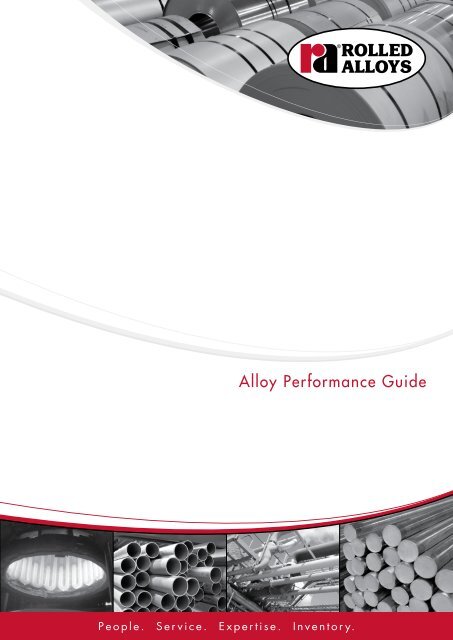
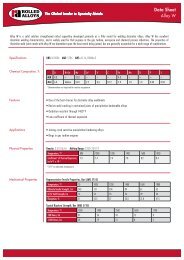
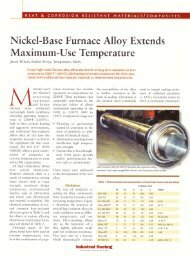
![RA333 Data Sheet [Heat Resistant Alloys] - Rolled Alloys](https://img.yumpu.com/50335849/1/190x245/ra333-data-sheet-heat-resistant-alloys-rolled-alloys.jpg?quality=85)
